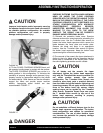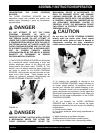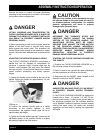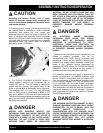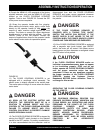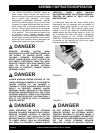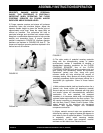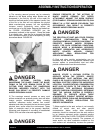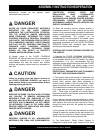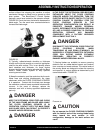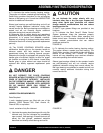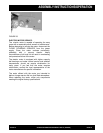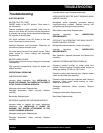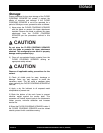
ASSEMBLY INSTRUCTIONS/OPERATION
SFCS-16 OPERATION AND PARTS MANUAL REV #4 (05/28/09) PAGE 26
c) The covering removal process can be extremely
abrasive to the blade cutting edge. Blades can be
sharpened in the field by the use of the metal file
stored on the fixed section of the operator handle. Use
of the file in the field will not duplicate the original
blade manufacturing process, but can significantly
increase overall productivity rates versus the
continued use of a dull blade. Remove the blade from
the FLOOR COVERING SCRAPER per the
procedures outlined in this manual. Clamp the blade
in a suitable vice. Use the file to sharpen the blade
with a procedure similar to that of sharpening a rotary
lawnmower blade. FIGURE 28.
FIGURE 28
DANGER
EXERCISE EXTREME CAUTION WHEN
SHARPENING THE BLADE. CLAMP THE BLADE
FIRMLY IN THE VICE. REMAIN CLEAR OF THE
CUTTING EDGE DURING THE SHARPENING
PROCESS. IMPROPER CONTACT WITH THE
BLADE CAN RESULT IN PROPERTY DAMAGE
AND/OR PERSONAL INJURY.
5) The coverings removal process on many work
surface materials can produce sparks, dust and other
foreign particle contamination. Many covering
materials, adhesives and/or mastics can contain
asbestos and other chemicals that are known to cause
physical harm and/or affect the environment. These
types of materials need to be properly identified,
contained and disposed of according to established
OSHA, EPA and other rules and regulations.
DANGER
SPARKS PRODUCED BY THE ACTIONS OF
BLADE AND/OR CERAMIC TILE RIPPER
ATTACHMENT AGAINST THE WORK SURFACE
(FOR EXAMPLE: STRIKING ANCHOR BOLTS) CAN
RESULT IN A FIRE AND/OR EXPLOSION. THIS
OCCURRENCE CAN RESULT IN PROPERTY
DAMAGE AND/OR PERSONAL INJURY.
DANGER
THE CREATION OF DUST AND OTHER FOREIGN
PARTICLE CONTAMINATION FROM THE
COVERING REMOVAL PROCESS CAN RESULT IN
PROPERTY DAMAGE AND/OR PERSONAL
INJURY. FOR SUCH OPERATING CONDITIONS,
ALWAYS WEAR A NIOSH/MSHA APPROVED
DUST/MIST RESPIRATOR AND APPROPRIATE
SAFETY RELATED APPAREL. CONSULT
APPLICABLE OSHA REGULATIONS FOR
SPECIFIC INFORMATION.
6) Dust and other particle contamination can be
controlled by the use an appropriate industrial type
vacuum system to remove/control dust and other
particle contamination from the work surface.
DANGER
ALWAYS UTILIZE A VACUUM SYSTEM TO
OPERATE WITHIN THE SPECIFIC JOBSITE
REQUIREMENT. DUST MATERIAL CAN MEET
CLASS II OR CLASS III SPECIFICATIONS OF THE
NATIONAL ELECTRIC CODE® FOR HAZARDOUS
LOCATION CLASSIFICATIONS. CONSIDERATION
MUST ALSO BE GIVEN TO THE CREATION OF
HAZARDOUS TYPE MATERIALS REQUIRING
SPECIFIC DISPOSAL PROCEDURES. DETERMINE
THAT THE VACUUM SYSTEM IS PROPERLY
DESIGNED TO OPERATE WITHIN THESE
ATMOSPHERES. CONSULT CURRENT NATIONAL
ELECTRIC CODE®, OSHA AND ENVIRONMENTAL
PROTECTION AGENCY REGULATIONS FOR
SPECIFIC INFORMATION.
7) Water applied to the work surface is not normally
utilized to control dust and other particle
contamination. Water, and/or other conductive
materials, should be removed from the work surface
by an industry approved and/or accepted practice
BEFORE utilizing the FLOOR COVERING SCRAPER
to remove the covering material. The presence of
water and/or any other conductive material on the
work surface can substantially increase the potential



